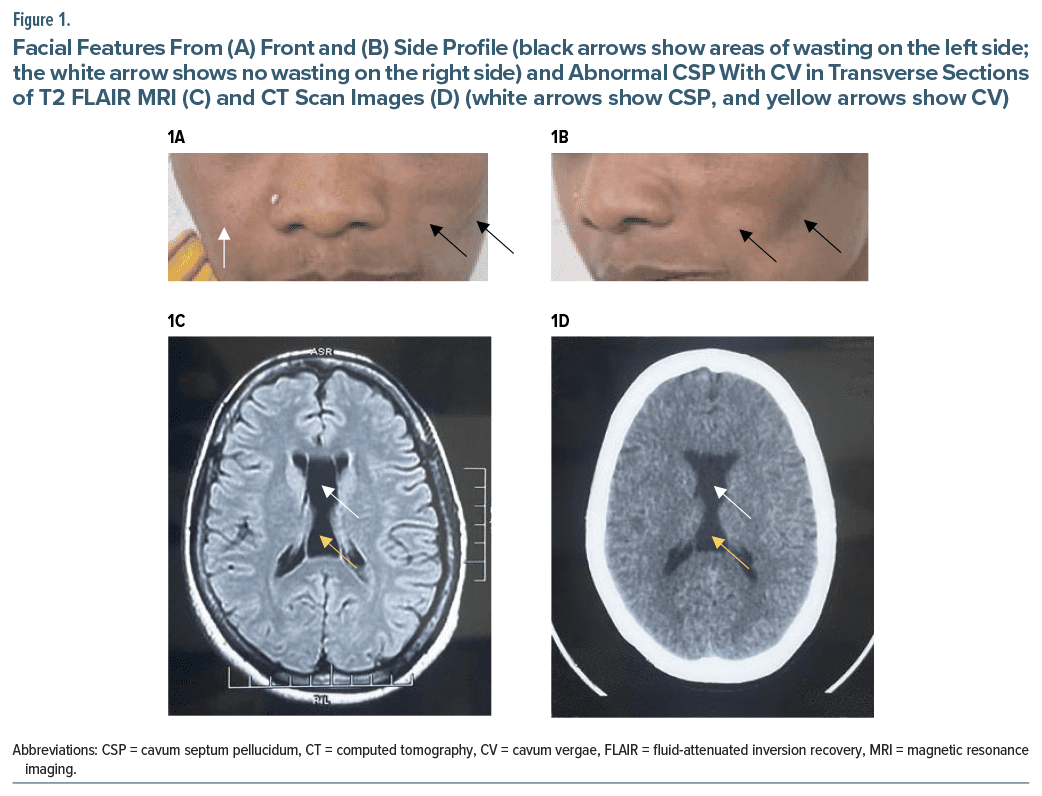Parry-Romberg syndrome (PRS) is characterized by progressive facial hemiatrophy that usually begins in the first decade of life. Skin with underlying soft tissue, muscles, bones, and sometimes eyes are involved. Its etiology is still largely unknown. The proposed etiopathogenesis involves genetic, embryonic neurodevelopmental, sympathetic nervous, inflammatory-immunologic, trauma, and metabolic dysfunctions.1 Strikingly, co-occurring neurological involvement is evidenced in some cases by both clinical and radiologic findings.2 Moreover, co-occurring psychiatric disorders such as depression and anxiety have also been reported in cases of PRS.3 We report a case of late-onset PRS clinically presenting with obsessive compulsive disorder (OCD) and abnormal cavum septum pellucidum (CSP), highlighting the role of embryonic neurodevelopment in the etiopathogenesis of PRS.
Case Report
Ms A is a 25-year-old married Hindu woman hailing from a rural background and a lower middle socioeconomic status. She presented to our outpatient department with a 4- year history of repeated and intrusive thoughts of dirt and contamination and repeated washing and cleaning. She was spending more than 6 hours a day in thoughts of dirt and acts of cleaning. The illness was chronic, continuous, and progressive. Since the onset of these symptoms, she also noticed tightness in the left side of the face. Gradually, she noted the prominence of the bones and wasting of skin and muscles on the left side of the face. Often, she complained of dragging pain on the left side of the face that lasted about 1–2 hours and was relieved by over-the-counter pain relief medications; there were no other associated features.
On examination, facial asymmetry was observed along with wasting of skin, soft tissue, and muscles on the left side of the face in the middle and lower part, with bony prominences (Figure 1A and 1B). There was no atrophic involvement of bones or orbital region. Physical examination revealed no other abnormality.
Her mental status examination revealed normal psychomotor activity and speech, anxious affect, obsessions of dirt and contamination, and compulsive cleaning and washing. Her insight into illness was present. The Yale-Brown Obsessive-Compulsive Scale (YBOCS)4 score was 24.
On neuroimaging (magnetic resonance imaging and computed tomography brain scan), CSP was noted. CSP was graded as “abnormal” or grade 4 considering the width and length of the CSP.5,6 CSP in the index case was seen to occupy more than half of the ventricular space and was >6 mm in length. In this case, cavum vergae, which is the posterior extension of the CSP, was also seen (Figure 1C and 1D). No other radiologic abnormality was noted. Other biochemical/immunologic test reports were within normal limits.
She was diagnosed with OCD with good or fair insight and was started on oral sertraline 25 mg, increased to 75 mg in the next 2 weeks. At 1- month follow-up, she showed good improvement, and her YBOCS score declined to 15. She showed no side effects to treatment.
Discussion
In the index case, PRS was most likely a result of embryonic neurodevelopmental abnormality that is evident from an abnormal CSP. Previous studies have shown an abnormal CSP to be significantly associated with OCD.5 This case, however, is the first to report OCD in PRS. Interestingly, autoimmunity and neuroinflammation, which has been hypothesized as an etiologic underpinning,1 have been shown to be significantly associated with OCD as well.7 This hypothesis to an extent might be strongly supported by the fact that symptoms of PRS and OCD evolved together in our case. Our case implies that late-onset PRS may have neurodevelopmental and neuroinflammatory/immunologic underpinnings and that the clinical presentation of PRS may be neuropsychiatric in the form of OCD.
Article Information
Published Online: May 7, 2024. https://doi.org/10.4088/PCC.23cr03695
© 2024 Physicians Postgraduate Press, Inc.
Prim Care Companion CNS Disord 2024;26(3):23cr03695
Submitted: January 2, 2024; accepted February 16, 2024.
To Cite: Shahane P, Tikka SK, Srirambhatla A, et al. Parry Romberg syndrome with abnormal cavum septum pellucidum presenting as obsessive-compulsive disorder. Prim Care Companion CNS Disord. 2024;26(3):23cr03695.
Author Affiliations: All India Institute of Medical Sciences, Bibinagar, Hyderabad, India (Shahane); Department of Psychiatry, All India Institute of Medical Sciences, Bibinagar, Hyderabad, India (Tikka, Malathesh, Spoorthy); Department of Radiodiagnosis, All India Institute of Medical Sciences, Bibinagar, Hyderabad, India (Srirambhatla).
Corresponding Author: Sai Krishna Tikka, MD, Department of Psychiatry, All India Institute of Medical Sciences, Bibinagar, Hyderabad, Telangana 508126, India ([email protected]).
Relevant Financial Relationships: None.
Funding/Support: None.
Patient Consent: Consent to publish the case report and photos was received from the patient. Information has been de-identified to protect anonymity.
References (7)

- Wong M, Phillips CD, Hagiwara M, et al. Parry Romberg syndrome: 7 cases and literature review. AJNR Am J Neuroradiol. 2015;36(7):1355–1361. PubMed CrossRef
- Vix J, Mathis S, Lacoste M, et al. Neurological manifestations in Parry-Romberg syndrome: 2 case reports. Medicine (Baltimore). 2015;94(28):e1147. PubMed CrossRef
- Stone J. Parry-Romberg syndrome: a global survey of 205 patients using the internet. Neurology. 2003;61(5):674–676. PubMed CrossRef
- Goodman WK, Price LH, Rasmussen SA, et al. The Yale-Brown Obsessive Compulsive Scale. I. Development, use, and reliability. Arch Gen Psychiatry. 1989;46(11):1006–1011. PubMed CrossRef
- Chon MW, Choi JS, Kang DH, et al. MRI study of the cavum septum pellucidum in obsessive-compulsive disorder. Eur Arch Psychiatry Clin Neurosci. 2010;260(4):337–343. PubMed CrossRef
- Khanra S, Srivastava NK, Chail V, et al. Prevalence and characteristics of cavum septum pellucidum in schizophrenia: a 16 slice computed tomography study. Indian J Psychol Med. 2016;38(5):455–459. PubMed CrossRef
- Gerentes M, Pelissolo A, Rajagopal K, et al. Obsessive-compulsive disorder: autoimmunity and neuroinflammation. Curr Psychiatry Rep. 2019;21(8):78. PubMed CrossRef
Please sign in or purchase this PDF for $40.
Save
Cite




